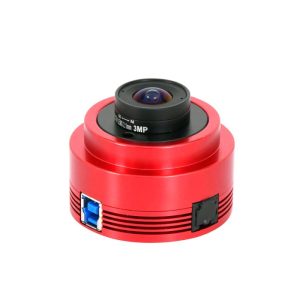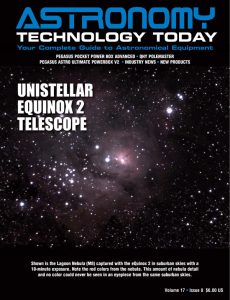The new ZWO ASI715MC is an uncooled color planetary and guiding camera that utilizes the Sony IMX715 sensor. It offers a low readout noise, high QE of 80% and a small pixel size of 1.45um.
 The sensitive 8.46 megapixel Sony IMX715 offers a 1/2.8” (5.6×3.2mm) sized sensor with a full well capacity of 6.03Ke, 12-bit ADC and a resolution of 3864×2192. The small pixel size of 1.45um makes the ASI715MC ideal for planetary photography.
The sensitive 8.46 megapixel Sony IMX715 offers a 1/2.8” (5.6×3.2mm) sized sensor with a full well capacity of 6.03Ke, 12-bit ADC and a resolution of 3864×2192. The small pixel size of 1.45um makes the ASI715MC ideal for planetary photography.
The ASI715MC comes with a USB 3.0 port for efficient transmission of data. The 5 GB bandwidth allows the ZWO ASI715MC to run at 45.1FPS, accurately transferring each frame. The built-in 256MB DDR cache ensures the captured images are perfectly maintained. It also includes a ST4 port, offering the flexibility as a guide camera.
The ZWO ASI715MC specifications include:
– Pixel Size in Microns: 1.45
– Camera Sensor: Sony IMX715
– Sensor Size: 1/2.8″
– Effective Pixel Array: 3864×2192
– Sensor Dimensions (mm x mm): 5.6 x 3.2
– Sensor Diagonal (mm): 6.45
– Peak Quantum Efficiency (QE): 80%
– Native Bit Depth: 12
– Max FPS or Full Frame Rate: 45.1
– Full Well: 6.0Ke
– Readout Noise: 0.72e
You can learn more about the ZWO ASI715MC here.

 And to make it easier for you to get the most extensive news, articles and reviews that are only available in the magazine pages of Astronomy Technology Today, we are offering a 1-year magazine subscription for only $6! Or, for an even better deal, we are offering 2 years for only $9. Click here to get these deals which only will be available for a very limited time. You can also check out a free sample issue here.
And to make it easier for you to get the most extensive news, articles and reviews that are only available in the magazine pages of Astronomy Technology Today, we are offering a 1-year magazine subscription for only $6! Or, for an even better deal, we are offering 2 years for only $9. Click here to get these deals which only will be available for a very limited time. You can also check out a free sample issue here.
The Sun is more active than it’s been in years and if that’s not enough, we have the upcoming Total Solar Eclipse on April 8, 2024! If you’d like to learn more about the technology behind solar observing, solar imaging and more, you can check out our new monthly magazine – Solar Astronomy Today. It’s free to read, no subscription needed and available here. And if you are preparing for the upcoming eclipses and want to know your equipment options from solar glasses to the most out of this world solar viewing and imaging options, check out our free publication – The Definitive Guide to Viewing and Imaging the Sun – simply click here and enjoy reading!



